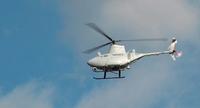-
Floating solar power plants offer many benefits
Water-based solar plants are at least 50 percent more efficient than a land-based solar power system.The water on which the plant floats helps extending the life of the photovoltaic panels, meaning greater efficiency and performance from the solar panel system, and the plant also prevents nearly 90 percent of the evaporation for the surface area that it covers, an important benefit in dry climates.
-
-
Wireless camera network offers new possibilities for security systems

Advances in computer technology are opening up new possibilities for surveillance cameras and environmental video monitoring systems. A graduate engineering student used off-the-shelf components to build a prototype device for a solar-powered wireless network of smart cameras with potential applications in security systems and wildlife monitoring.
-
-
Pumping Central Valley’s ground water increases number of California’s earthquakes
Scientists have offered a new theory explaining the steady increase in the number of small earthquakes in parts of Central California. They say that the quakes are partly due to the pumping of groundwater. Groundwater is heavy, and depresses the Earth’s upper crust like a weight. Without that weight, the earth springs upward and the change in pressure can trigger more small earthquakes.
-
-
New technology tests ammo while saving joints
Firing and testing thousands of rounds of ammunition weekly can challenge the human body — even ones in top physical condition — causing debilitating stress injuries and chronic nerve and joint pain. DHS Science and Technology Directorate (S&T), with the help of agents from ICE Office of Firearms and Tactical Programs (OFTP) Armory Operations Branch (AOB), has taken an important step forward in reducing or eliminating these injuries by developing of the “Virtual Shooter.”
-
-
Abundant shale gas, by itself, not likely to alter climate projections
While natural gas can reduce greenhouse emissions when it is substituted for higher-emission energy sources, abundant shale gas is not likely substantially to alter total emissions without policies targeted at greenhouse gas reduction, a new study finds. If natural gas is abundant and less expensive, it will encourage greater natural gas consumption and less of fuels such as coal, renewables and nuclear power. The net effect on the climate will depend on whether the greenhouse emissions from natural gas — including carbon dioxide and methane — are lower or higher than emissions avoided by reducing the use of those other energy sources.
-
-
UN mulling rules to govern autonomous killer robots
On Tuesday, delegates from several international organizations and governments around the world began the first of many round of talks dealing with some call “lethal autonomous weapons systems” (LAWS), and others call “killer robots.” Supporters of LAWS say the technology offers life-saving potential in warfare, as these robots y are able to get closer than troops to assess threats without letting emotions interfere in their decisions. This is precisely what concerns critics of the technology. “If we don’t inject a moral and ethical discussion into this, we won’t control warfare,” said one of them.
-
-
Research reconfirms that public investment in scientific research promotes growth
New and independent research has reconfirmed and quantified some of the economic and societal benefits of public investment in scientific research. The report says that for every £1 spent by the U.K. government on R&D, private sector R&D output rises by 20p per year in perpetuity, by raising the level of the U.K. knowledge base.
-
-
Colorado tries to increase safety of urban development in wildfire-prone areas
Colorado continues to deal with the challenge of building new urban developments while reducing wildfire risks. There are currently 556,000 houses built in burn zones around the state, and the demand for water to sustain residents and industries continue to rise. A new study predicts that development will occupy 2.1 million acres in wildfire-prone forests by 2030, an increase from one million acres today — just as wildfires continue to burn roughly 900,000 acres a year since 2000, compared with just 200,000 acres a year in the 1990s.
-
-
Improving gloves to enhance first responders’ safety
Firefighters wear protective gloves called “structure gloves” to keep their hands safe on the job. The structure gloves currently used by firefighters, however, are not designed for the precision movements first responders must perform. There are many different types of structure gloves available, but none fully satisfies modern firefighters’ needs. Today’s compact tools often have small buttons that require nimble movements. Bulky gloves can make it difficult for firefighters to complete simple tasks without removing their gloves and compromising their safety. As advanced textile technology and materials continue to develop, the science behind firefighter structure gloves has adapted.
-
-
Limiting methane emissions would more quickly affect climate than limiting CO2
When discussing climate change, scientists point to “radiative forcing,” a measure of trapped heat in Earth’s atmosphere from man-made greenhouse gases. The current role of methane looms large, they say, contributing over 40 percent of current radiative forcing from all greenhouse gases. The role of methane as a driver of global warming is even more critical than this 40 percent value might indicate, they note, since the climate system responds much more quickly to reducing methane than to reducing carbon dioxide. The implication is that while it is true that in order to slow, or even reverse, global warming we must limit emissions of both carbon dioxide and methane, it makes more sense to concentrate now on limiting methane emissions because reducing methane emissions would buy society some critical decades of lower temperatures.
-
-
Coral reefs offer valuable protection for coastal infrastructure
Growing natural hazards from coastal storms, flooding, and rising sea levels are leading to major investments worldwide in coastal defense structures such as seawalls and breakwaters. A new study shows that coral reefs can provide risk reduction benefits comparable to artificial defenses, and reef restoration and enhancement is a cost-effective alternative to manmade structures. Restoring coral reefs as a way to protect coastal infrastructure is also cheaper: the typical price for a tropical breakwater project is $197 million, compared with $129 million for restoring a reef.
-
-
Teams from U.S. service academies demonstrate potentially transformative technologies
DARPA’s mission is to ensure the technological superiority of U.S. military forces, and the agency continually seeks new sources of talent to accomplish that goal. The U.S. three military service academies are a promising source of that talent. The U.S. Air Force Academy team wins new competition — DARPA Service Academies Innovation Challenge — designed to encourage students at U.S. military academies to develop groundbreaking solutions to challenges facing the U.S. armed forces.
-
-
Public schools must accept children regardless of citizenship, immigration status: DOJ
Last week, the Obama administration reaffirmed its position on public school education for children, regardless of their citizenship or immigration status. The state and district obligations regarding school enrollment are influenced by the result of the 1982 Supreme Court decision in Plyler V. Doe, which discarded a Texas law that denied education funding for undocumented children. Some states like Alabama and Arizona have passed their own education laws, but these have been superseded by the 1982 Supreme Court ruling.
-
-
FAA grants NJIT permission to test UAVs

On 8 May the FAA awarded the New Jersey Institute of Technology (NJIT) a Certificate of Waiver/Authorization (COA), making it the first New Jersey university and first public institution in the state granted permission to test the unmanned aircraft systems (UAS). NJIT will use the airstrip on the U.S. Coast Guard Training Center in Cape May to test the systems.
-
-
Loss of West Antarctic glacier unstoppable, contributing significantly to sea level rise
A rapidly melting section of the West Antarctic Ice Sheet appears to be in irreversible decline, with nothing to stop the entire glacial basin from disappearing into the sea, according to researchers at UC Irvine and NASA. The new study presents multiple lines of evidence — incorporating forty years of observations — that six massive glaciers in the Amundsen Sea sector “have passed the point of no return.” The volume of melted ice would be enough to raise global sea level by four feet.
-
More headlines
The long view
New Technology is Keeping the Skies Safe
DHS S&T Baggage, Cargo, and People Screening (BCP) Program develops state-of-the-art screening solutions to help secure airspace, communities, and borders
Factories First: Winning the Drone War Before It Starts
Wars are won by factories before they are won on the battlefield,Martin C. Feldmann writes, noting that the United States lacks the manufacturing depth for the coming drone age. Rectifying this situation “will take far more than procurement tweaks,” Feldmann writes. “It demands a national-level, wartime-scale industrial mobilization.”
How Artificial General Intelligence Could Affect the Rise and Fall of Nations
Visions for potential AGI futures: A new report from RAND aims to stimulate thinking among policymakers about possible impacts of the development of artificial general intelligence (AGI) on geopolitics and the world order.
Smaller Nuclear Reactors Spark Renewed Interest in a Once-Shunned Energy Source
In the past two years, half the states have taken action to promote nuclear power, from creating nuclear task forces to integrating nuclear into long-term energy plans.
Keeping the Lights on with Nuclear Waste: Radiochemistry Transforms Nuclear Waste into Strategic Materials
How UNLV radiochemistry is pioneering the future of energy in the Southwest by salvaging strategic materials from nuclear dumps –and making it safe.
Model Predicts Long-Term Effects of Nuclear Waste on Underground Disposal Systems
The simulations matched results from an underground lab experiment in Switzerland, suggesting modeling could be used to validate the safety of nuclear disposal sites.
